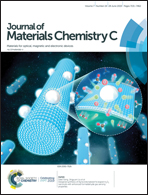Effectively restricting MnSi precipitates for simultaneously enhancing the Seebeck coefficient and electrical conductivity in higher manganese silicide†
Abstract
As an earth-abundant, low-cost, and eco-friendly thermoelectric material, higher manganese silicide has attracted extensive research interest in recent years. However, MnSi precipitates can easily form in the synthesized higher manganese silicide and are difficult to remove completely. Here, we demonstrate that by introducing Mg2Si into higher manganese silicide, we can effectively suspend the formation of MnSi precipitates, which leads to a reduced effective mass, a reduced optimized carrier concentration, and an enhanced optimized figure of merit, zT. With further reducing carrier concentration to the optimized level due to MnSi suspension, the Seebeck coefficient and electrical conductivity have been simultaneously increased and the optimized zT has been realized. Benefiting from the enhanced power factor derived simultaneously from the increased electrical conductivity and Seebeck coefficient due to the optimized carrier transport properties, zT of the as-prepared higher manganese silicide has been enhanced from 0.32 to 0.47 at 773 K while the lattice thermal conductivity also slightly reduced. This study indicates that MnSi can be effectively suspended via introducing Mg2Si leading to simultaneously enhanced Seebeck coefficient and electrical conductivity and subsequently increased zT.



 Please wait while we load your content...
Please wait while we load your content...